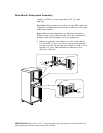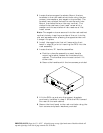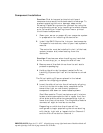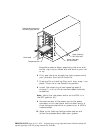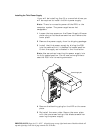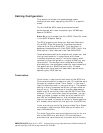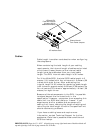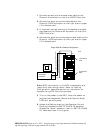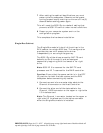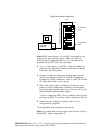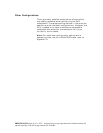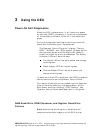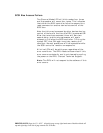
PRINTER NOTE: Page size 9” x 9.25”. Align this page to top, right hand corner. Back box bleeds off
top and right edge. Left side of page extends to 9.25 inches.
Note: Shielded data cables, such as those provided
with the subsystem, must be used to prevent radio
frequency interference. It is recommended that you use
the cables provided with your system. These cables
have been tested and meet stringent guidelines set
forth by SCSI-3 ANSI specifications.
Ultra Wide SCSI Mode
Several possible configurations exist for the DEU in
Ultra Wide SCSI mode. However this manual will
discuss the two possible configurations using the I/O
Interface card in Ultra Wide SCSI mode: dual-bus
module in a single cabinet and single-bus module in a
single cabinet. Refer to the Appendix D when using the
Ultra Extender card.
Note: When configuring a dual-bus cabinet, both
channels of the Host Controller are connected to each
bank of drives through each channel on the I/O
Interface card. When configuring the single-bus
cabinet, one channel of the Host Controller connects
both banks of drives only through the right or upper
channel (Channel 1) on the I/O Interface card.
Dual-Bus Cabinet
This configuration provides two separate SCSI bus
connections to the drives.
From the front, the drives slots are divided into two
banks. The left or upper four front drive slots, which
are connected to “Channel 1” on the I/O Interface card,
and the right or lower four front drive slots are
connected to “Channel 0” on the I/O Interface card.
The SCSI IDs of the drives are set by SAF-TE card
defaults to IDs 0, 1, 2, and 4, from the front beginning
with the drive located on the right or lower slot of each
bank. The SCSI IDs can be manually changed from the
OCP, if required. Both banks of drives will use the
same sequence of SCSI ID numbers when the Dual-Bus
module is installed.
Note: SCSI ID 3 is reserved for the SAF-TE card
processor.
Caution: Ensure that the power switch is in the OFF
(O) position for both the host system and the DEU
subsystem before connecting any cables.




